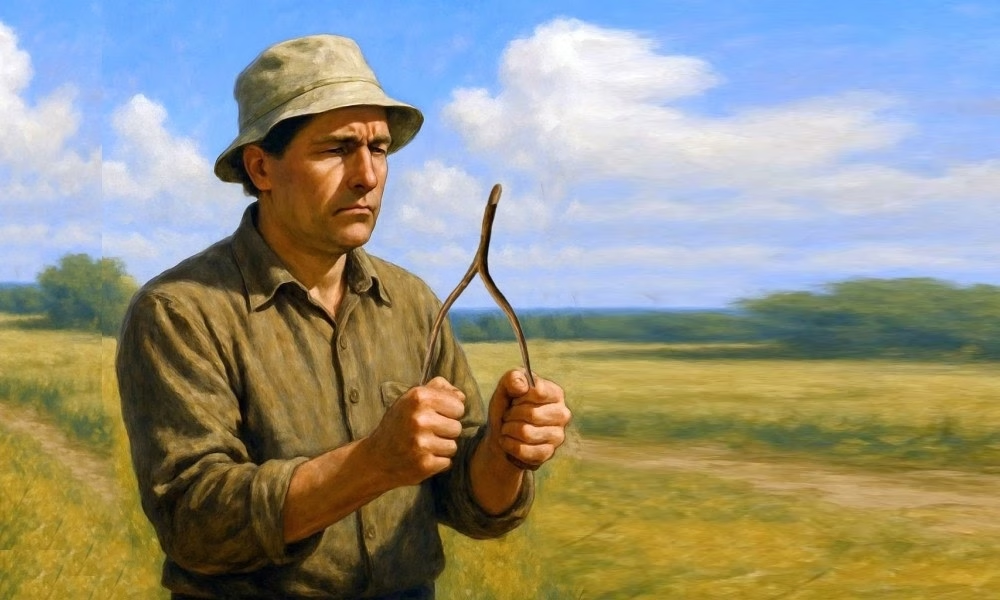
Dowsing, also known as water witching or divining, is the practice of using a forked stick, metal rods, or even a bent coat hanger to locate underground water sources. The idea is simple: when a dowser walks over a hidden vein of water, the stick or rods supposedly twitch, dip, or cross, signaling the presence of precious groundwater beneath.
Practitioners believe that their tools act as sensitive detectors, responding to subtle vibrations, magnetic fields, or mysterious “earth energies.” Some even claim that dowsing can find buried treasure, lost objects, or even missing people (a much more serious leap).
Historical Relevance
Dowsing isn’t a modern invention—it dates back at least to the 15th century in Europe, where miners in Germany used it to search for ore deposits. The first known depiction of dowsing shows a man with a forked branch searching for minerals, not water. The technique spread through Europe and later to colonial America, becoming a common method for locating well sites.
By the 17th century, dowsers were often called “water witches,” especially in England and America—sometimes with a touch of suspicion. In times when scientific understanding of groundwater was virtually nonexistent, a man with a stick seemed as good an option as any.
Even today, many rural communities around the world still call on local dowsers when they need a new well dug. Some companies even advertise professional “dowsing consultations” alongside geological surveys.
What It Means Today
Despite centuries of anecdotal successes, scientific investigations into dowsing have almost uniformly come up dry. Controlled experiments show that dowsers perform no better than chance when searching for hidden water sources.
In double-blind tests (where neither the dowser nor the experimenter knows where the water is), dowsers often fail to locate it at rates no better than simple guessing. In fact, large-scale studies—like the famous 1987 Munich tests—found that even experienced dowsers could not outperform random selection.
So why does dowsing seem to work for so many people? A few reasons:
- The Ideomotor Effect: This is a well-documented psychological phenomenon where small, unconscious muscle movements cause motion in dowsing rods or sticks. Essentially, the dowser is moving the stick without realizing it.
- Confirmation Bias: If someone believes dowsing works, they tend to remember the “hits” (when they successfully find water) and forget the “misses.”
- Geology’s Little Secret: In many regions, if you dig almost anywhere deep enough, you will eventually hit groundwater. A successful dowser might simply be playing the odds without knowing it.
Put another way: if you wave a stick around long enough in a watery area, you’re probably going to feel like a wizard eventually.
Important Facts, Figures, and Characters
- The Munich Experiment (1987-1988): One of the most comprehensive studies on dowsing ever conducted. Researchers tested dozens of dowsers under controlled conditions. The final verdict? Dowsers performed no better than random guessing. The scientific community largely considers this the death knell for dowsing as a legitimate method of water detection.
- James Randi’s $1 Million Challenge: The late magician and skeptic James Randi famously offered $1 million to anyone who could demonstrate a paranormal ability under controlled conditions—including dowsing. Several self-proclaimed dowsers tried… and failed.
- Thomas Edison and Dowsing?
Even the great inventor himself reportedly explored dowsing late in life—but not to find water. Edison hoped to use it to locate underground ore deposits. Whether this was serious research or one of Edison’s many wild ideas remains unclear. - Dowsing’s Staying Power: Despite debunking, surveys show that a surprising percentage of people—up to 40% in some polls—believe dowsing can locate water. Some well drillers even report bringing a dowser along “just in case,” blending old superstition with modern technology.
The Lighter Side
If you’ve ever watched someone dowsing, it’s almost hypnotic—the slow, deliberate walk, the squinting concentration, the tense grip on the Y-shaped branch. It feels ancient, like something out of a forgotten ritual.
There’s also something charmingly human about it: a deep desire to sense hidden forces, to connect with nature directly rather than relying on dry reports and seismic surveys. Who wouldn’t want to be the person who can just feel where the good water is?
But while it’s a fun tradition—and great material for small-town legends—trusting dowsing alone to find your next well site might leave you with nothing but a big dry hole and a hefty drilling bill.
Final Verdict
Dowsing for water is one of those practices that stubbornly persists at the intersection of folklore, wishful thinking, and human psychology. Science has tested it, debunked it, and moved on—but dowsing remains alive and well in the popular imagination.
After all, a guy walking around with a stick is a lot cheaper than a hydrological survey. Just don’t forget your checkbook if the drilling rig arrives.




